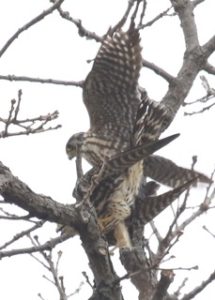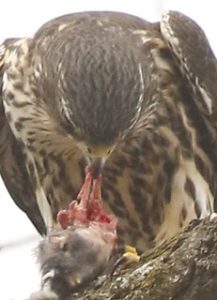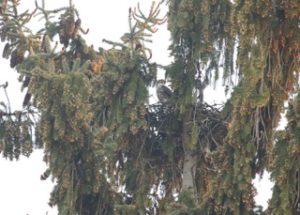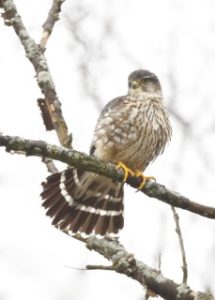
Back on April 3, 2017, I was in a northeast Lake County area when I heard a loud, unusual bird chattering along with various birds and an Eastern Gray Squirrel running for cover. Suddenly, a Merlin came flying by, chasing after some prey. Over the next week, when checking on this area, I continued to see this adult male actively hunting, sometimes diving into suburban front yards, other times pulling up and perching in a nearby oak. At that time, I figured this male must be a late migrant, hindered from migrating by the ongoing strong north winds.
Investigating the area again on April 8th, I heard Killdeer distress calls, but to my surprise, I soon discovered it was the same male Merlin giving the calls, something I later understood was related to its nesting cycle. What transpired next stunned me. This male flew towards the top of a Bur Oak, whereupon it landed next to a female Merlin, who started to give repeated similar calls (but sounding more like a wounded Killdeer). It was a Merlin pair and they were clearly on a territory! Over the next half hour, I watched what I later realized was their courtship flight, the male, sometimes the female, circling in horizontal flight with fluttering wings, giving those Killdeer-like calls the whole time and overall having an appearance similar to flying Monk Parakeets.
As if this wasn’t exciting enough, at the end of one of his fluttering circles, calling the whole time, he then landed on top of the female and copulated for a second! Soon after, he did this again, staying for two seconds and prepared for this stunning event, I was able to secure the first Illinois photographs of copulating Merlins.
Immediately after the copulation, the male flew off, only to return soon after with a prey item (mouse or small bird), which it plucked its feathers/fur and then left the food item on a conifer branch, intended as dinner for its now established mate.

Merlins don’t make their own nests, instead using crow or hawk nests. In the alley behind the lookout oak perch tree was an active crow nest. This crow pair clearly was not sharing my excitement at the significant ornithological history occurring in their midst. Interestingly, I never heard the crows give any calls or attempt to drive away these Merlins. It almost seemed like they didn’t know exactly what these birds were, only that there was some form of danger in their midst, so they remained silent as they examined the situation. On the evening of the first copulation and dinner, I later saw the female Merlin fly up to this Norway Spruce and enter the crow nest. It looked like the Merlin’s were taking over the active crow nest and with copulation that afternoon, egg laying would be expected by the morning – the first confirmed Merlin active nest in Illinois history!
Nevertheless, at my next visit here, the crows had returned and were brooding on their nest. It looked like the crows might have won the skirmish over the rights to this nest. Meanwhile, the Merlins continued on for weeks to come, continuing to actively use the tall oak lookout perch, the male hunting and daily bringing food to the waiting female (a known courtship activity).
I visited this area a couple times at end of the day and found both Merlins quite active heading into sunset, using various tall tree perches together. I found them actively using the area more than half a mile to the west/northwest and half a mile to the south/southeast of the crow nest site.
This tall oak was in suburban front yard and was daily used as a lookout perch over the area, along with affording a view of the nearby nest. It continued as their main perch, at least until the oak leaves grew by the end of May. Also during April and May, adjacent to this Bur Oak lookout perch, another shorter tree was used as a feeding perch, easily confirmed by all the small feathers and white ‘splash’ beneath it. This tree was the end of the driveway, so many drivers passing by could have easily seen this Merlin perched and feeding.
I personally saw kill items of a mouse, junco, sparrow (probable White-crowned), White-breasted Nuthatch and most amazing, both Chimney Swift and a Barn Swallow, all brought to the female to feed on. It was like the female did no hunting at all during this courtship period, perhaps a test to see if the male could regularly provide for her. Merlins are not like other falcons in their hunt technique. They sit on perches, often high up, where they can get a global view of the area and from where they can launch out on an attack, giving its ‘Killdeer’ like call as they fly horizontally with amazing speed, ultimately catching their prey. Catching a fast, agile Chimney Swift or Barn Swallow in flight were more than enough evidence to convince me of their amazing hunting abilities.

But what of their breeding? Pair on territory, daily courtship routines, male feeding female multiple times a day, copulation seen at least four times by April 12th… yet still not official nest being used. Would this just go down as a failed dry run for this pair? After all, this was incredibly far south of their expected nesting range. In their normal range, I read that nesting typically started after the onset of May, so I had hopes things would turn around, especially as this pair continued to actively keep this small yard territory into May.
With the continued unseasonable cold weather and north winds into the second week of May, it was becoming apparent to me that the next strong southerly front would be the proof as to whether this pair was actually going to nest or if it was going to be recorded as a failed breeding attempt. I never did see the actual encounter between the crows and Merlins, if even there was one. The daily ‘pressure’ of having these falcons adjacent to their nest might have been too much for the crows and perhaps they voluntarily left. On the other hand, there could have been some sort of death skirmish. However it happened, by the second week of May, the crows had abandoned their nest in this Norway Spruce, setting up the possibility of the Merlins taking it over. Merlins like having a nest in an evergreen where they can fly in and land on the branch next to it, along with the nest providing a view of the larger territory surrounding it. They apparently don’t have to be high up, although this nest site would be considered on the high end, at least 60 feet up.

A strong warm front arrived by midday May 15th and either the Merlins perceived its arrival and began laying eggs (as early as May 9th, following a night of copulation and multiple feedings by male) or began immediately laying eggs the day after this warm front. Either way, I was able to happily confirm their return to this chosen former crow nest site by May 16th. This nest was so deep that the brooding female was typically not seen, only rarely a small portion of its tail sticking up out of nest. She typically revealed her presence when the male, with its high pitched calls, brought her next meal. On those occasions, the female left the nest, took the male’s catch and went to a nearby perch to feast. Meanwhile, the male actually went up to the nest and did nest brooding duties until the female had completed its meal. On one occasion, I saw the female get out of the nest and fly southeast, upon which the male came to sit on the nest, suggesting she did occasional hunting for herself.
With egg hatching taking about a month and fledgling an additional month, it appears as if mid-July would provide the first information on whether young will survive the nest. Fledglings are apparently fed by adults for another four weeks, so this nest story is expected to be complete by mid-August. If fledglings survive until next year, the hope is that this general area, with its expansive great habitat for what Merlins look for in nesting, could become an epicenter for their range expansion into Illinois. 2012 seemed to be a year of increasing reports from central Wisconsin, followed by three confirmed nesting in that region in 2015, along with an amazing two nests that summer on the north side of Milwaukee – less than 45 miles from the Illinois stateline!
With Merlins now sporadically nesting in the lower half of Wisconsin, along with ten Illinois June to July ebird Merlin records in the last 5 years, there’s already a suggestion that range expansion is already underway in various northern tier locations in our state.
by Eric Walters
